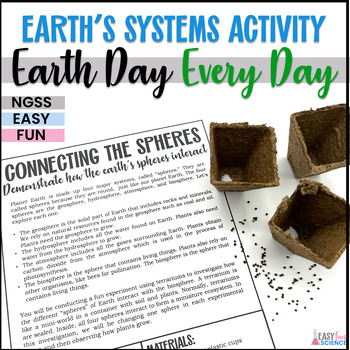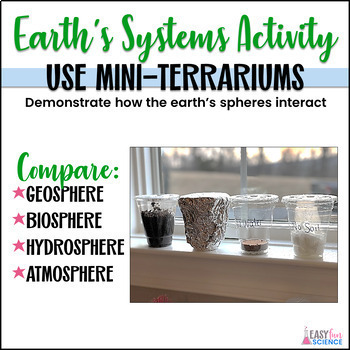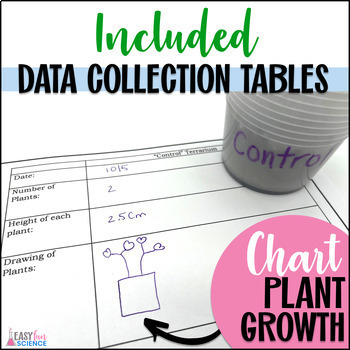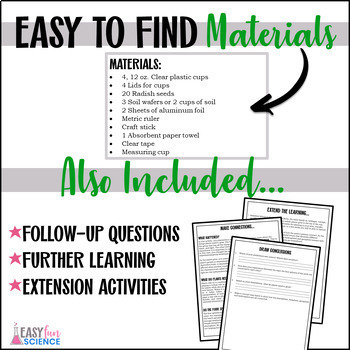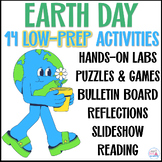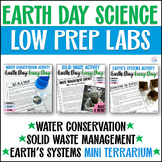Earth Day Activities 5th 6th 7th Grade: Earth's Spheres (Hydro Litho Atmo Bio)
- PDF
Also included in
- Celebrate Earth Day with this collection of LOW-PREP and FUN science activities for middle and high school students. This resource has everything you need for an amazing Earth Day unit... Earth Day Bulletin Board resources, reading comprehension, puzzles, games, hexagonal thinking activity, slideshoPrice $19.99Original Price $30.65Save $10.66
- Celebrate Earth Day with this collection of LOW-PREP and FUN science activities for middle school students. This resource has everything you need for amazing Earth Day science labs unit! Earth Day Resources Included in this Resource:Solid Waste Management ActivityWater Conservation ActivityEarth'sPrice $6.50Original Price $8.50Save $2.00
- Celebrate Earth Day with this collection of LOW-PREP and FUN science activities for middle school students. This resource has everything you need for amazing Earth Day science labs unit! Earth Day Resources Included in this Resource:Solid Waste Management ActivityWater Conservation ActivityEarth'sPrice $10.48Original Price $11.65Save $1.17
Description
- Looking for fun and easy Earth Day Activities? Add this one to your list! With this experiment, students will investigate how the four spheres of the Earth - the hydrosphere, lithosphere, atmosphere, and biosphere - interact with one another. Each experimental group will involve changing one sphere, while the other three remain constant. Students will observe how the plants grow in each terrarium over a period of several weeks and make comparisons to draw conclusions about the importance of each sphere.
This Earth Day Activity is a fun and engaging way to teach students about the interconnectedness of the Earth's systems and how changes to one sphere can have a significant impact on the entire ecosystem. Plus, it's a great hands-on way to get students excited about science and ecology, and it is a perfect experiment to kick off this year's Earth Day.
What does this resource include?
- Materials list for each activity, so you can easily gather everything you need before you get started
- Background information for students to prepare them to understand the activity
- Easy preparation which will save you time
- Expected results for each activity so you don't have to do the activity ahead of time
- Student instructions as printable worksheets, with places for students to record responses as they work through the experiment. This is especially helpful for students that may lose their place if they need to flip to a separate lab report.
- Data recording sheets for the control group and the experimental groups
What will students do?
Students will set up 4 mini terrariums, including a "normal" terrarium with soil, water and sunlight. This is the control group. The experimental groups include a terrarium without soil, a terrarium without water, and a terrarium without sunlight. Students will make observations and take measurements several times a week, and then use their data to compare how Earth's spheres are connected.
Who is this resource for?
- Classroom Teachers
- Homeschool Parents
- Homeschool Co-op Teachers
- Christian School Teachers
- Enrichment Teachers
- Special Education Teachers
This product supports the following Next Generation Science Standards (NGSS):
- 5-ESS2-2
Looking for more Earth Day Activities for Middle School? Check out my other products:
- Earth Day BINGO or Find Someone Who...
- Earth Day Two Truth and a Lie Game or Warm-Up
- Earth Day Bulletin Board Posters Famous Conservationists and Environmentalists
- Earth Day Famous Conservationists Slideshow
- Earth Day Reflection Hexagonal Thinking Activity
- Earth Day Bulletin Board Letters
- Earth Day Reading Comprehension, Puzzles and Reflection
- Ugly Sweater Endangered Animals Activity
- Solid Waste Management Activity
- Water Conservation Activity
- Earth Day BIG BUNDLE of 14 Activities
- Earth Day Activity BUNDLE of 3 Hands-On Labs
- Earth Day GAME BUNDLE
- Earth Day NO PREP Activity Bundle
- Earth Day BULLETIN BOARD BUNDLE
Follow Easy Fun Science on Instagram for updated lessons, STEM Your Faith, ideas for teaching in the classroom/homeschool, and science experiment hacks!!

